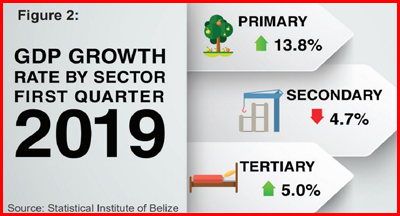 On Wednesday, June 26, 2019, the Statistical Institute of Belize (SIB) published its latest statistics on Belize’s economic performance. The country’s consumer price index has remained virtually unchanged, and imports and exports are up and down, respectively, for 2019. It also shows an increase of 5.2% in the country’s economic growth and that the unemployment rate has dropped to 7.6%.
On Wednesday, June 26, 2019, the Statistical Institute of Belize (SIB) published its latest statistics on Belize’s economic performance. The country’s consumer price index has remained virtually unchanged, and imports and exports are up and down, respectively, for 2019. It also shows an increase of 5.2% in the country’s economic growth and that the unemployment rate has dropped to 7.6%.
The figures show that the All-Items Consumer Price Index stood at 104.7 in both May 2018 and May 2019. The cost of goods and services regularly purchased remained relatively unchanged in comparison to the same period last year.
Belize’s imported goods valued as much as $169.4 million in May 2019, a $3.1 million increase from the same month last year. Merchandise imports for the first five months of 2019 totaled $771.8 million, representing a 2.6% or $19.5 million increase from the same period last year. The country’s domestic exports for the month of May 2019 was $37.1 million, down a whopping 35.6% or $20.5 million from the $57.6 million recorded for May 2018.
For the first three months of 2019, the level of economic activity for the country of Belize increased by 5.2 % when compared to the same period of 2018. Preliminary estimates by the SIB indicated that the value of goods and services produced during the first quarter of this year was $782 million, up $38.6 million from $743.4 million produced during the same quarter of 2018. The primary and tertiary sectors both experienced notable growth during the first quarter of 2019, with primary activities increasing by 13.8 %, due largely to higher sugarcane, banana, and livestock production, and tertiary activities rising by 5 %, as a result of growth in tourism and wholesale and retail trade. The secondary sector, on the other hand, contracted by 4.7 %, as electricity generation and construction activities declined during the quarter.
SIB’s preliminary results from its April Labour Force Survey indicated that the national unemployment rate for that month was 7.6%, a decrease of 1.8% from 9.4% in April 2018. This has been the lowest rate ever recorded and resulted from a net increase of 8,478 in the number of persons with jobs coupled with a number of persons exiting the labor force.
Approximately 177,915 persons were estimated to be in the labor force in April 2019. A net increase of 5,829 persons was observed, of which 73% or about 4,231 were males. This was in contrast to what was seen last year, when there was a large influx of women into the labor force. Notwithstanding this increase in the number of persons in the labor force, the Cayo district registered a net decline of 1,300 persons. About two-thirds of the working age population were a part of the labor force, either holding jobs or available for employment. However, women remained far less likely to be a part of the labor force, with a participation rate of 53 %, compared to almost 80 % among males. For both males and females, participation was highest in persons aged 35 to 44 years, and lowest in the 14 to 24 years age group.




